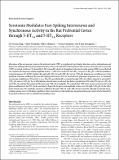Serotonin Modulates Fast-Spiking Interneuron and Synchronous Activity in Prefrontal Cortex through 5-HT[subscript 1A] and 5-HT[subscript 2A] Receptors
Author(s)
Watakabe, Akiya; Ushimaru, Mika; Yamamori, Tetsuo; Kawaguchi, Yasuo; Puig Velasco, Maria Victoria
DownloadPuig-2010-Serotonin Modulates.pdf (2.709Mb)
PUBLISHER_POLICY
Publisher Policy
Article is made available in accordance with the publisher's policy and may be subject to US copyright law. Please refer to the publisher's site for terms of use.
Alternative title
Serotonin Modulates Fast-Spiking Interneuron and Synchronous Activity in the Rat Prefrontal Cortex through 5-HT1A and 5-HT2A Receptors
Terms of use
Metadata
Show full item recordAbstract
Alterations of the serotonergic system in the prefrontal cortex (PFC) are implicated in psychiatric disorders such as schizophrenia and depression. Although abnormal synchronous activity is observed in the PFC of these patients, little is known about the role of serotonin (5-HT) in cortical synchrony. We found that 5-HT, released by electrical stimulation of the dorsal raphe nucleus (DRN) in anesthetized rats, regulates the frequency and the amplitude of slow (<2 Hz) waves in the PFC via 5-HT[subscript 2A] receptors (5-HT[subscript 2A]Rs). 5-HT also modulates prefrontal gamma (30–80 Hz) rhythms through both 5-HT[subscript 1A]Rs and 5-HT[subscript 2A]Rs, but not 5-HT[subscript 2C]Rs, inducing an overall decrease in the amplitude of gamma oscillations. Because fast-spiking interneurons (FSi) are involved in the generation of gamma waves, we examined serotonergic modulation of FSi activity in vivo. Most FSi are inhibited by serotonin through 5-HT[subscript 1A]Rs, while a minority is activated by 5-HT[subscript 2A]Rs, and not 5-HT[subscript 2C]Rs. In situ hybridization histochemistry confirmed that distinct populations of FSi in the PFC express 5-HT[subscript 1A]Rs and 5-HT[subscript 2A]Rs, and that the number of FSi expressing 5-HT2CRs is negligible. We conclude that 5-HT exerts a potent control on slow and gamma oscillations in the PFC. On the one hand, it shapes the frequency and amplitude of slow waves through 5-HT[subscript 2A]Rs. On the other hand, it finely tunes the amplitude of gamma oscillations through 5-HT[subscript 2A]R- and 5-HT[subscript 1A]R-expressing FSi, although it primarily downregulates gamma waves via the latter population. These results may provide insight into impaired serotonergic control of network activity in psychiatric illnesses such as schizophrenia and depression.
Date issued
2010-02Department
Picower Institute for Learning and MemoryJournal
Journal of Neuroscience
Publisher
Society for Neuroscience
Citation
Puig, M. Victoria et al. “Serotonin Modulates Fast-Spiking Interneuron and Synchronous Activity in the Rat Prefrontal Cortex through 5-HT1A and 5-HT2A Receptors.” J. Neurosci. 30.6 (2010): 2211-2222. © 2010 The Society for Neuroscience
Version: Final published version
ISSN
1529-2401